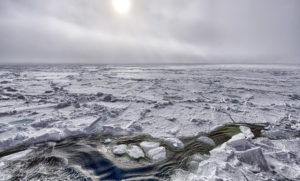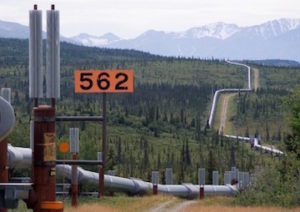Ice-Free Arctic Pinpointed 40 Years Ahead
The melting of the Arctic ice cap has become so fast and so certain that researchers can now confidently predict when the region will become ice free to within four years.
By Tim Radford, Climate News NetworkThis piece first appeared at Climate News Network.
LONDON — People have been warning about an ice-free Arctic ocean for years. But Jiping Liu, an atmospheric scientist at the State University of New York in Albany in the US and colleagues have gone one better.
They predict that the Arctic Ocean will be effectively free of ice for the first time in the month of September between 2054 and 2058.
Once again, the prediction depends on climate models, and inevitably on the decisions governments take to control greenhouse gas emissions in the next decade. But the fact that a team of scientists can spread their bets over a span of four specific years is an indicator of how fast and how inexorable the Arctic melting has become.
The polar icecap has been dwindling in area and losing its thickness for decades: the observations by satellite have been confirmed by submarine measurements and icebreaker journeys. An icecap that was, historically, impassable even in summer has for years given way each autumn to ever greater stretches of open water.
From 1979 to 2001, the ice cap dwindled by more than 6% per decade, and in 2001 began melting twice as fast, The ice melt broke all previous records in 2007, and in 2012 did it again, reaching an all-time low.
Widespread and significant impacts
On September 16 last year it stood at almost 49% below the long term average and the ice left floating on the sea had dwindled to an area of 3.4 million square kilometres.
In the Proceedings of the National Academy of Sciences, Dr Liu and colleagues define “ice-free” as a mere million square kilometres, and propose that if greenhouse gas emissions stay at a high level, then in some September between 2054 and 2058, that’s all that will be left in the Arctic Ocean: a million square kilometres of floe and slush.
This would, say the researchers, have “significant impacts” on Arctic ecosystems and maritime activities, biogeochemical feedbacks and extreme weather and climate in the high and mid-latitudes.
In 2012, the extent of ice in September had almost halved: what interested the researchers was when it would halve again, falling to 1.7 million square kms. Precisely when this happened depended on which climate model they used, but it always happened at some point: in the 2060s, under one set of conjectured circumstances, and in the 2040s under others.
And, they point out, with only 1.7million sq kms in their models the Arctic Ocean becomes a viable “open ocean” shipping route, with thick and multi-year ice found only in a tiny portion of the northern Canadian archipelago.
Your support matters…Independent journalism is under threat and overshadowed by heavily funded mainstream media.
You can help level the playing field. Become a member.
Your tax-deductible contribution keeps us digging beneath the headlines to give you thought-provoking, investigative reporting and analysis that unearths what's really happening- without compromise.
Give today to support our courageous, independent journalists.






You need to be a supporter to comment.
There are currently no responses to this article.
Be the first to respond.